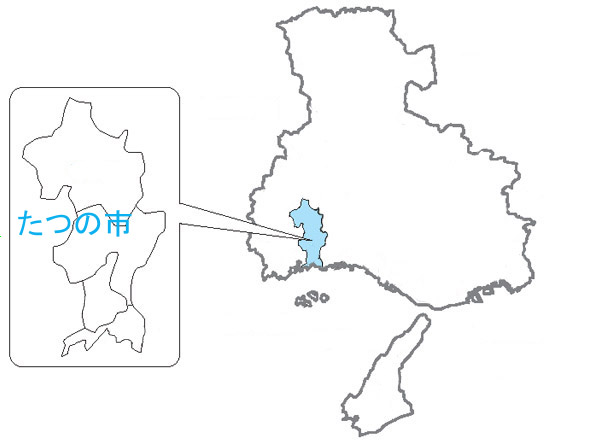About Tatsuno City > City Outline
Main content starts here.
Update:March 6, 2020
City Outline
Location and Geography
Tatsuno City is located in the West Harima region of southwest Hyogo Prefecture, and runs lengthwise from north to south.
The region is blessed with a natural environment – mountains stretch across the north, the south area faces the Seto Inland Sea, and the Ibo River runs from north to south.

Tatsuno City covers a total land area of 210.93km2– 15.7km from east to west and 29.8km from north to south.
Climate
With an annual temperature of about 15ºC, and annual rainfall at around 1,200 – 1,300mm, the area shows characteristics of the warm and dry Seto Inland Sea climate.
Population/Households
Total population: 76,000
Total number of households: 31,000
Outline
Tatsuno City was formed by the amalgamation of the old Tatsuno City and the towns of Shingu, Ibogawa and Mitsu on October 1st, 2005. It has developed along with the Ibo River which runs from north to south and has an abundance of nature and history.
The city has a lot of greenery, such as the mountains in the north, the primeval forest of Mt. Keiro, and other places of nature, such as the most famous shallow beach in Kansai – Shinmaiko, in the Setonaikai National Park, and plum groves. It also has many historical sites such as the Shingu Miyauchi Ruins, the nationally designated Important Cultural Property Kamo Shrine, the Nagatomi family residence, Tatsuno Castle and the old streets of the Wakizaka (53,000 koku) Domain. It also has Murotsu Port, which flourished as a post station in the Edo Period.
By making full use of Tatsuno’s abundant tourist sites, the city was one of five organizations across the country elected to receive the 2007 Outstanding Tourism Development Award, and is taking this opportunity to work on promoting tourism all the more.
In addition to the long established local industries of tenobe somen noodle and soy-sauce production and the leather and bag industries, the area is continuing to develop its high-tech and electric industries. It also has a thriving and distinctive agriculture which produces flowers and trees, shikokumai (purple and black rice), soft vegetables, tomatoes, daikon radishes and others.
On the other hand, at the Harima Science Garden City in the north west, research and development on the next generation synchrotron radiation source ‘X-ray free electron laser (XFEL)’ is progressing at facilities such as SPring-8, the world’s highest performing large synchrotron radiation facility, and work is progressing with the aim of becoming an international science garden city.
